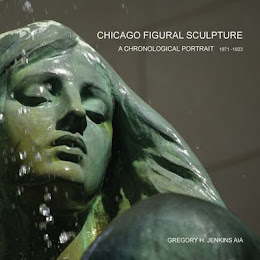Isak Dinesen, in her essay "Daguerreotypes" makes an interesting reference to our relationship with the past. Generally summarizing (and I recommend a direct "read") she explains that people over the age of 50 who were lucky enough to have contact with people over the age of 50 during their childhood and youth have direct knowledge of the world of 100 years ago from people who saw it.
Direct knowledge.
For me, that means stories from Indiana farmers who followed the railroad north from the Ohio River Valley about trips to Chicago at the turn of the Century. For Bob Perrone, it means first hand knowledge of the remarkable career of his grandfather, Rene Paul Chambellan. Bob left a comment on my post of August 26, 2009. And that communication has given me a most welcomed, first hand connection to the Sculpture of Tribune Tower.
Today was a remarkably warm, sunny September day. Tourists (lots of them, swarms of them) on north Michigan Avenue, guidebooks in hand, were touching the stones embedded in the stone walls of the Tribune Building. (The Parthenon. The Colosseum.) And then looking up to Aesop's screen, and above, those oddly inspired figures of "Rumor" and "News".
Direct knowledge.
For me, that means stories from Indiana farmers who followed the railroad north from the Ohio River Valley about trips to Chicago at the turn of the Century. For Bob Perrone, it means first hand knowledge of the remarkable career of his grandfather, Rene Paul Chambellan. Bob left a comment on my post of August 26, 2009. And that communication has given me a most welcomed, first hand connection to the Sculpture of Tribune Tower.
Today was a remarkably warm, sunny September day. Tourists (lots of them, swarms of them) on north Michigan Avenue, guidebooks in hand, were touching the stones embedded in the stone walls of the Tribune Building. (The Parthenon. The Colosseum.) And then looking up to Aesop's screen, and above, those oddly inspired figures of "Rumor" and "News".
.
.
The reaction of each tourist was the same. First, eyes wide, amazed. And second, a huge smile brought with the discovery that "humor" could be a part of the architecture of "the most beautiful building in the world." We need to remember to thank the "Frog."






















































No comments:
Post a Comment